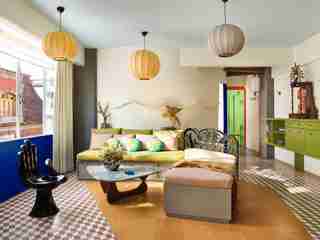Mexico City’s bustling Centro Histórico neighborhood is like an architectural crazy quilt. Stitched into its crowded streets, you’ll find Spanish Colonial cathedrals, Art Nouveau museums, and the remains of Aztec temples—after all, the city is actually built upon the ruins of Tenochtitlan, the ancient capital of the Aztec empire. So, when the L.A.-based interior designer Jessica Ayromloo was hired to design her friend’s CDMX pied-à-terre, she recalls, “I wanted it to compliment what was outside.”
Her client was Carlos Rittner, the longtime president of CR Creative Services, a company that handles warehousing and installation for interior designers. The two had met while Ayromloo was working at the office of AD100 designer Kelly Wearstler (she launched her own firm in 2012), and he called on her to transform an apartment in a 1940s converted office building into a place that could host his family as well as a steady stream of artists passing through the creative capital. (Rittner recently opened Artbug, an L.A. gallery with a focus on Latin American artists.) He needed adequate accommodations for guests, and only a petite kitchen. Otherwise, he gave Ayromloo carte blanche saying, “I told her to do what she would do for herself.”
They ripped out existing walls, added a few guest baths, and created a striking trapezoidal guest bedroom (“it was inspired by indigenous architecture,” the designer notes of the unusual shape) in the center of the apartment. Once they had stripped things back to the bones, Ayromloo looked out the windows for inspiration. The snakelike molding of a nearby building inspired a similar wavy motif she used as a sort of wainscoting in the living room. The terra-cotta exterior of a church across the street was incorporated into the dizzying tumbling block tiles by Rayito de Sol that wrap floors and walls, pieced together with sheets of cork—a page from the Wearstler playbook, who Ayromloo recalls, “would take a scarf and turn it into a floor.”
“That’s just what it’s like walking around Mexico City,” explains Ayromloo, who used Comex paints to conjure CDMX’s vibrancy inside. “There are pops of color everywhere—tiles mixed together, color-blocked exteriors, there’s no real rhyme or reason for it.”
Some furniture—like a 1960s, mosaic-topped dining table and a writing desk painted by David Serrano—came from Downtown, the erstwhile L.A. design mecca (the founders have since moved to Mérida, Mexico), which the client had long worked with. But the majority was sourced around Mexico from Trouvé, the blue-chip CDMX vintage dealer, antique shops in nearby Puebla, and the sprawling local flea market, La Lagunilla.
“We would go out, get tacos, walk around, go to museums, just get inspired,” explains Ayromloo of their intuitive, hyper-local design process. “We had a floor plan and ideas, but a lot of times they would change or morph based on things we would see with each trip.”
An antique door accented with acid green, sourced in Puebla and used as a headboard, set the color scheme in the primary bedroom. Meanwhile, salvaged ironwork pieces attributed to midcentury design star Arturo Pani found at La Lagunilla were turned into a component of the modular sofa. “We would just find things and figure out how to use it for another purpose,” Ayromloo explains. Case in point: Dragon-shaped sconces from the flea market became shelf brackets, and copper plates became sconces.
Such clever details and smart sourcing brought the pulse of the neighborhood into the home. “In the Centro you feel the history,” explains Rittner, who is happy to have his little piece of it. “There are hundreds of museums and restaurants; it’s like Disneyland for adults. It feels good to have this nice space with a lot of color where you wake up and you want to explore the city.”

A dazzling, tumbling, block-patterned cement tile by Rayito de Sol delivers a jolt of color to the entryway along with walls painted in Comex’s Colonial blue and Amapola red. The vintage chair as well as the copper plates turned sconces were scored at La Lagunilla.

In this Mexico City apartment by Jessica Ayromloo, color and pattern reign. In the petite kitchen and dining area, the floors and walls are clad in a patchwork of cork and tile by Rayito de Sol, the Art Deco pendant and 1950s chandelier are from La Lagunilla, and the 1960s mosaic dining table and 1950s Allan Gould scissor chairs are from Downtown. The painting is by Nick Farhi.

In the living room, design icons including Pedro Friedeberg’s hand chair and Isamu Noguchi’s cocktail table sit with a custom modular sofa (it can double as a twin-size bed for guests), which incorporates an ironwork grate by the midcentury Mexican design star Arturo Pani. The accent wall is painted in Comex’s Colonial blue.
An antique door sourced in Puebla, southeast of Mexico City, is repurposed into a headboard, a perfect counterpoint to walls painted Comex’s Langosta pink in the primary bedroom and decorated with masks from La Lagunilla. The pink pendant light is by Mexican brand Casamidy, and the vintage end tables are by Drexel. The cement tiles are by Rayito de Sol, and the Oaxacan textile on the bed is from Textil Indigena in the Shops at Downtown Hotel.
This workspace in the primary bedroom features a 2008 desk painted by David Serrano from Downtown. The floor lamp, chair, and object were all sourced at the Lagunilla flea market. The accent wall is painted in Comex’s Salto.
In the primary bath, wrapped in Greek marble, the 1950s Italian tole pineapple sconce is from Downtown, and the vintage ceiling fixtures and mirrored wood panels that compose the vanity are both from La Lagunilla.
In the guest bedroom, all the antiques were sourced from the Lagunilla flea market. The walls are painted with Comex’s Popcorn.
In the guest bath, through a door painted Comex’s Amapola red, a custom lamp was created using a strip of LED.

Leave a Reply